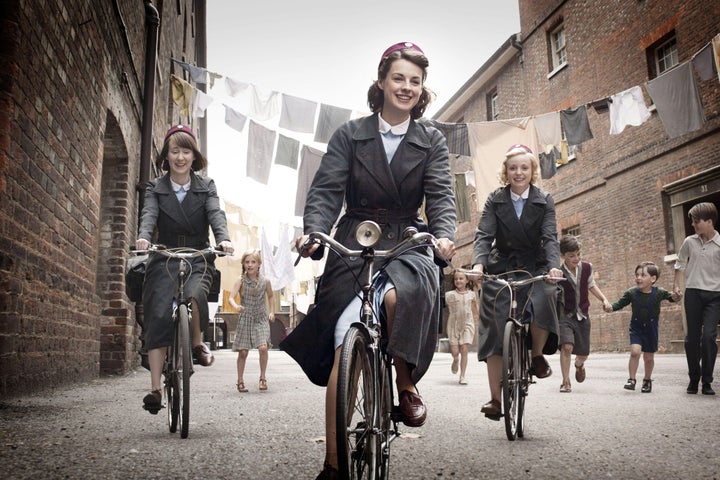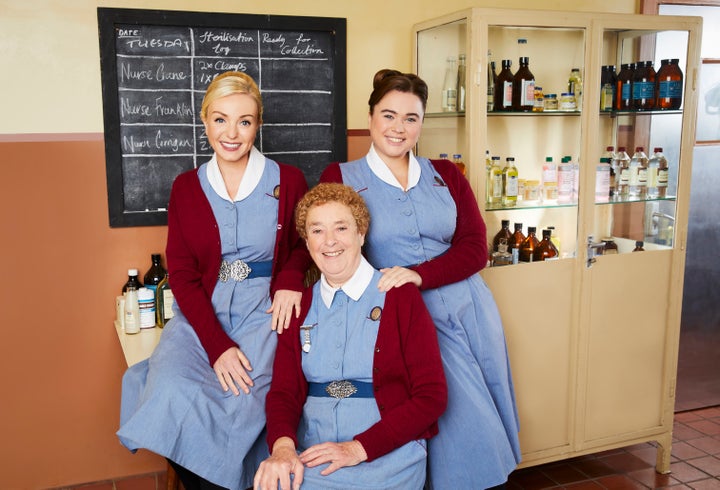
I discovered “Call the Midwife” in late 2020 when a mom in my neighborhood recommended it. We met the way I befriended most people during the summer of 2020 — from a distance — shouting across front yards or standing (at least) 6 feet apart on the street, with my newborn and 19-month-old parked in their stroller.
Her daughter was just a few months younger than mine, and, like me, my neighbor was doing the bulk of the child care while her spouse worked from home. This meant her days were also built around taking long walks in the morning before it got too hot, then passing time with snacks and puzzles and play until it was somehow, finally, nap time.
During that golden hour (or two), she told me she liked to rest on the couch and watch one episode of “Call the Midwife,” a show about the nurses and nuns of Nonnatus House in the 1950s and ’60s who work together delivering babies and caring for women in London’s impoverished East End.
“My husband doesn’t understand why I watch it because it always makes me cry, but I love it,” she said during one of our socially distanced conversations.
As a regular viewer of other British shows, like “Killing Eve” and “Downton Abbey,” I’d heard of “Call the Midwife,” but I wasn’t sure it was my type of TV; I didn’t like to think of myself as sentimental or a crier, so I didn’t immediately add it to my queue.
A few months later, I was scrolling Netflix on a dreary January night after the kids were in bed. I was both extremely isolated, because my family was still sheltering in place amid the winter COVID surge, and exhausted from nine months of taking care of two young children without any outside help. I was also still grieving for my mom, who died of cancer a year before COVID hit. Under these circumstances, I was looking for two things in a new show to binge: entertainment and comfort. I found both in “Call the Midwife.”

The pilot of the series, based on the memoirs of real-life midwife Jennifer Worth, begins in 1957 as Nurse Jenny Lee (Jessica Raine) arrives in the East End to start her new job at Nonnatus House, which she does not realize is a convent. She appears as out of place among the house’s nuns and the neighborhood’s poverty as I felt mothering during a pandemic.
Though I was grateful for the privilege of being able to isolate from the virus, I was still struggling with this lonely and unexpected version of motherhood. Everything had been different than I anticipated since the morning of my 39-week checkup, when I was crying in my obstetrician’s office because the world was shutting down. I didn’t know if my husband would be allowed in the delivery room, or if we could find someone to watch our daughter while I gave birth. During delivery, everyone was quiet and masked and scared. When we returned home with my 2-day-old son, people were sanitizing groceries and mail; there was no Meal Train or visitors to hold him while I breastfed or showered or napped. There was no one else to entertain my daughter in the morning when my husband and I were exhausted from nights spent rocking and feeding and tracking diapers.
This isolation and sleep deprivation made me miss my mom even more. I couldn’t call her to ask small questions, like “How do you breastfeed a baby and play with a toddler at the same time,” or big questions, like “How did you do it all?” (My brother and I were only 11 and a half months apart.) I couldn’t text her the picture of my daughter’s proud smile the first time she held her little brother. I couldn’t call her crying when I was overwhelmed and just needed her to listen, to let me get it all out so I could keep going.
Watching “Call the Midwife” and seeing the way the nuns and nurses (and Dr. Turner, played by Stephen McGann) cared for each woman during delivery and in the days and weeks that followed made me realize that what I missed most after the birth of my son was the support of other women. I missed the momentary respite of female spaces and the shared understandings that take place inside them. Conversing across yards and streets was great, but it wasn’t enough. Neither were my mom-friend text threads.
I wanted a knock at the door — Midwife calling. I wanted a woman to sit across from me at the kitchen table and share a cup of tea. I wanted someone like Nurse Franklin (Helen George) to say There, there, sweetie in a way that acknowledged my pain and promised me that I’d survive it.
Bingeing “Call the Midwife” gave those things to me. The show portrayed the feminine community I craved, especially during the height of the pandemic, and I sped through the nine seasons that were available on Netflix at the time.
Each season takes place over the course of a single year. The show is now in its 12th season, so it has covered the late 1950s through the end of the 1960s. This time frame enables the show to depict universal problems of motherhood — like miscarriages and traumatic births and unplanned pregnancies and abuse — while contextualizing them within the realities of specific historical events, such as the thalidomide scandal and the invention of birth control pills.
“The show portrayed the feminine community I craved, especially during the height of the pandemic, and I sped through the nine seasons that were available on Netflix at the time.”
The passage of time is most apparent in the changes in childbirth from the 1950s to the 1960s. It begins in the first season as an event that takes place primarily at home with glass enema nozzles and bowls of hot water as husbands wait downstairs. In Season 2, with the introduction of “gas and air” for pain relief, Dr. Turner opens a maternity home that allows women to give birth in a safe, clean space without having to go to a hospital. As the seasons progress, home births decline as more women choose to deliver in hospitals, some men choose to be more involved during the delivery and delivery methods change (this season introduces a vacuum to replace forceps).
As women gain options to reduce the pain and danger of childbirth, it comes at an expense. Labor becomes more clinical and less personal. It’s the women of Nonnatus House who continue to honor each woman’s humanity when they perform prenatal checkups and conduct home visits and deliver babies.
It’s also the women of Nonnatus House who advocate for the women they serve — including the access to contraception and abortion — because it’s these same women who have watched the horrors of unsafe abortion, who have treated the women hemorrhaging and dying after a botched procedure, who have seen the consequences of women being forced to have babies. The show reminds me that women have always faced unique systemic challenges, that decisions about our bodies have long been made by others. But, even when it feels hopeless, there is the hope of progress. This lesson feels especially prescient now, post-Roe v. Wade, as does the pro-choice letter Nurse Franklin writes to The Times in Season 10.
These societal shifts also emphasize that the unique challenges women face are always changing, as is the way each generation defines motherhood. However, despite these shifts, the support and service of Nonnatus House are unwavering even when the many of the characters who live there leave (this is something Nurse Crane, played by Linda Bassett, struggles with, especially this season). Only a handful of original characters are still on the show: Sister Julienne (Jenny Agutter), Sister Monica Joan (Judy Parfitt), Nurse Franklin and Nurse Turner (Laura Main).
Like in real life, characters — including the original protagonist, Jenny Lee — leave because they move or change professions or get married or have babies or, like Barbara (Charlotte Ritchie), they die. Sometimes they even leave to seek help for mental health issues, such as this season when Lucille (Leonie Elliott) returns to Jamaica because of the depression she experiences after the grief of a miscarriage and pressures of racism and xenophobia.
The characters of “Call the Midwife” are as susceptible to the natural triumphs and tragedies of life as the women they serve and the viewers who watch them. Unlike medical shows like “Grey’s Anatomy,” where devastation often serves as a plot device or cliffhanger, in “Call the Midwife” it is framed and executed as the very essence of life. Sickness and death and darkness are as much a part of our humanity as health and birth and lightness. More often than not — in a way that women in the midst of childbirth or mothering can understand — it is both.
The narration (by Vanessa Redgrave), from the perspective of an older Jenny, drives this duality home for the viewer. The wisdom she speaks at the end of each episode is just as likely to make me cry — because it turns out I actually am a crier at my core — as the first wail of one of the show’s impossibly small, pink, miraculous babies.
“The characters of “Call the Midwife” are as susceptible to the natural triumphs and tragedies of life as the women they serve and the viewers who watch them.”
I started binge-watching “Call the Midwife” because it gave me a sense of community that I lacked during the pandemic, but I continue watching it because it is a reminder of the burdens and gifts of motherhood. During my daily life with two young children — now 4½ and 3 — it is often impossible to take the time to feel this.
There are apples to slice and shoes to put on and tantrums to endure and mud pies to make and fevers to cool, and the days still pass in a blur, leaving me exhausted by the time my kids are finally asleep.
It’s also isolating.
Even though it’s not the height of a pandemic, it is still hard to connect with my friends. There’s a work deadline or a kid gets sick or a sibling has a ballet recital or someone’s partner is out of town.
In the midst of my chaotic daily life, I pause to watch new episodes of “Call the Midwife” because — like my friend resting on her couch — it is the break I need to remember that my journey is shared. The highs and lows of mothering do not happen in isolation. Watching “Call the Midwife” gives me a safe space to acknowledge this, to remember the women, like my mom, who came before me and to honor my journey as a mother now.
As Mother’s Day approaches, I hope every mother out there can take time to feel this — however that looks for you. Personally, I’m going to rest, curl up on the couch and watch an old episode of “Call the Midwife” and let the tears (and laughs) come as they may.
CORRECTION: A previous version of this story incorrectly said “Killing Eve” aired on “Masterpiece.”
